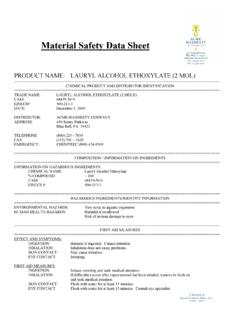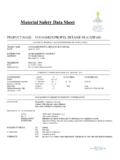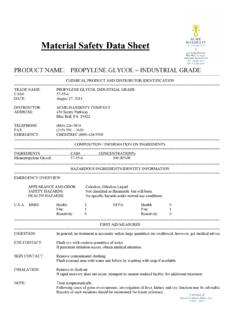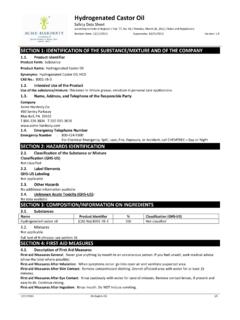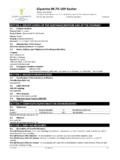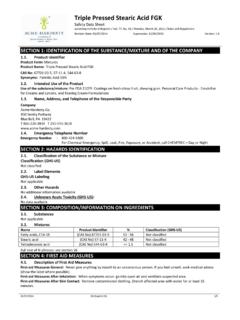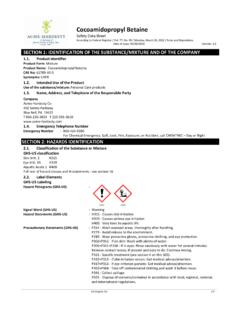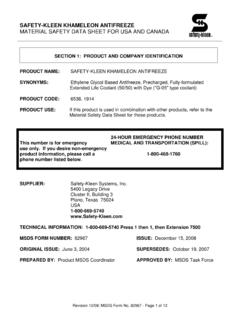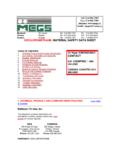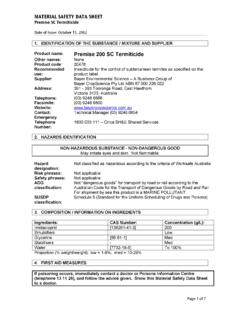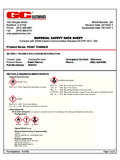Transcription of Material Safety Data Sheet - Acme-Hardesty
1 Material Safety data Sheet PRODUCT NAME: dioctyl sebacate ======================================== ======================================== ============= IDENTIFICATION AND DISTRIBUTOR INFORMATION ======================================== ======================================== ============= TRADE NAME: dioctyl sebacate CAS #: 122-62-3 DATE: May 29, 2008 DISTRIBUTOR: Acme-Hardesty COMPANY ADDRESS: 450 Sentry Parkway Blue Bell, PA 19422 TELEPHONE: (866) 226 3834 FAX: (215) 591 3620 EMERGENCY: CHEMTREC (800) 424-9300 ======================================== ======================================== ============= COMPOSITION / INFORMATION ON INGREDIENTS ======================================== ======================================== ============= INGREDIENT: dioctyl sebacate CHEMICAL NAME: Bis(2-ethylhexyl) sebacate CHEMICAL FAMILY: Ester CHEMICAL FORMULA.
2 C26H50O4 CAS# %WT %VOL SARA 313 REPORTABLE 122-62-3 99% Not reportable PPM mq/m3 OSHA PEL-TWA: Not available OSHA PEL STEL: OSHA PEL CEILING: ACGIH TLV-TWA: Not available ACGIH TLV STEL: ACGIH TLV CEILING: ======================================== ======================================== ============= HAZARDOUS IDENTIFICATION ======================================== ======================================== ============= POTENTIAL HEALTH EFFECTS: EYES: May cause irritation SKIN: May cause irritation INGESTION: -- INHALATION: -- MEDICAL CONDITIONS GENERALLY AGGRAVATED BY EXPOSURE: None reported.
3 May be harmful by inhalation, ingestion, or skin absorption. To the best of our knowledge, the chemical, physical, and toxicological properties have not been thoroughly investigated. Material Safety data Sheet dioctyl sebacate May 29, 2008 Page 2 of 5 ======================================== ======================================== ============= ACCIDENTAL RELEASE MEASURES ======================================== ======================================== ============= Absorb with inert Material .
4 Put the spilled Material in an appropriate waste disposal. Keep away from heat and other sources of ignition. Stop leak if without risk. On land, dyke; In water set up a dam and contact appropriate authorities. ======================================== ======================================== ============= FIRST AID MEASURES ======================================== ======================================== ============= EYES: Flush eyes with copious amounts of water for at least 15 minutes, occasionally lifting upper and lower lids.
5 Consult a physician if irritation appears. SKIN: Flush skin with plenty soap and water for at least 15 minutes while removing contaminated clothing and shoes. Contact a physician if irritation persists. INGESTION: Not a likely source of exposure. If swallowed, however, wash out mouth with water provided person is conscious. INHALATION: Remove from exposure to fresh air immediately. If not breathing, give artificial respiration. If breathing is difficult, give oxygen. ======================================== ======================================== ============= FIRE FIGHTING MEASURES ======================================== ======================================== ============= FLASH LIMITS IN AIR (% BY VOLUME): UPPER: Unknown LOWER: Unknown FLASH POINT: F, 227 C (OC) AUTO-IGNITION TEMP: 500 F, 227 C UNUSUAL FIRE / EXPLOSION HAZARDS: -- HMIS CLASSIFICATION: HEALTH: 1 FLAMMABILITY: 1 REACTIVITY.
6 0 PERSONAL PROTECTION: H NFPA CLASSIFICATION: HEALTH: 1 FLAMMABILITY: 1 REACTIVITY: 0 EXTINGUISHING MEDIA: Use water fog, alcohol resistant foam, dry-chemical, or carbon dioxide SPECIAL PROCEDURES: As in any fire, wear self-contained breathing apparatus in pressure demand. MSHA/NIOSH (approved or equivalent), and full protective gear. During a fire, irritating and highly toxic gases may be generated by thermal decomposition or combustion. HAZARDOUS DECOMPOSITION: As with other organic materials, combustion will produce carbon monoxide and carbon dioxide.
7 Material Safety data Sheet dioctyl sebacate May 29, 2008 Page 3 of 5 ======================================== ======================================== ============= HANDLING & STORAGE ======================================== ======================================== ============= Avoid contact with eyes, skin and clothing. Wash thoroughly after handling. Remove contaminated clothing and wash before reuse. Avoid eye contact and inhalation. Use with adequate ventilation. Store in cool, dry place.
8 Keep container closed when not in use. ======================================== ======================================== ============= EXPOSURE CONTROLS / PERSONAL PROTECTION ======================================== ======================================== ============= ENGINEERING CONTROLS: Ventilation is recommended in order to maintain vapor concentration below permitted limits. Make sure an emergency eye wash and a shower can be found at the work place. VENTILATION: Mechanical ventilation is recommended.
9 RESPIRATORY PROTECTION: Use MSHA/NIOSH respirator. EYE PROTECTION: Wear chemical goggles. SKIN PROTECTION: Wear compatible chemical resistant gloves and sufficient clothing to minimize physical contact. HYGIENIC PRACTICES: During application, adequate ventilation must be approved. ======================================== ======================================== ============= PHYSICAL/CHEMICAL CHARACTERISTICS ======================================== ======================================== ============= APPEARANCE: ABOVE ROOM TEMP: clear oily liquid BELOW ROOM TEMP: crystalline solid ODOR: Mild pH: N/AAvailable BOILING POINT, C: 255 @ 20 mm Hg FREEZING/MELT POINT: -- VAPOR PRESSURE @ 210 C: VAPOR DENSITY (AIR=1).
10 SPECIFIC GRAVITY (water=1): EVAPORATION RATE: Negligible SOLUBILITY IN WATER: MOLECULAR WT: VISCOSITY@ 40 C: ======================================== ======================================== ============= STABILITY & REACTIVITY ======================================== ======================================== ============= STABILITY: Stable under normal conditions CONDITIONS TO AVOID: None reported. INCOMPATIBILITY: Strong oxidizing agents HAZARDOUS DECOMPOSITION: Irritating and toxic fumes and gases.
